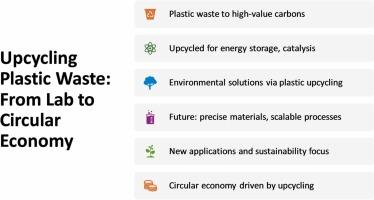塑料废物升级为先进碳材料:在能源和环境中的应用综述
引用次数: 0
摘要
这篇综述强调了升级回收,这是一种有前途的战略,将各种塑料流转化为高价值的碳基材料。全球塑料垃圾的积累不断升级,目前每年超过4亿吨,要求从线性获取-制造-处理模式向循环经济模式进行根本性转变。该手稿综合了将主要塑料类型:聚丙烯(PP)、聚对苯二甲酸乙二醇酯(PET)、聚苯乙烯(PS)和聚乙烯(PE)转化为石墨烯(GNs)、碳纳米管(CNTs)、活性炭(ACs)、碳纳米片(CNS)和无序硬碳(HC)等功能碳的进展(2020-2025)。这些材料显示出非凡的潜力。在能量存储方面,它们增强了超级电容器和电池的性能。在催化方面,它们是析氢反应(HER)、析氧反应(OER)和氧还原反应(ORR)的高效电催化剂,并有助于光催化和类芬顿降解。它们通过吸附和电化学处理在环境修复中也很有效,并有助于先进材料的合成。它们与新兴技术的结合,包括钙钛矿太阳能电池(PSCs)和摩擦纳米发电机(TENGs),扩大了它们的用途。初始生命周期评估(LCA)研究证实了它们的环境效益,显示了气候变化潜力和人类毒性的降低。未来的研究应优先考虑精密材料设计,多功能混合材料(例如碳与金属氧化物集成),以及先进的原位表征,以了解结构-性能关系。通过技术经济分析和建模开发可扩展的、节能的流程至关重要。通过社会LCA (S-LCA)和政策框架实现应用的多样化并确保整体可持续性,将加速向可持续循环经济的过渡。本文章由计算机程序翻译,如有差异,请以英文原文为准。

Upcycling plastic waste into advanced carbon materials: A comprehensive review of applications in energy and environment
This review highlights upcycling, a promising strategy transforming diverse plastic streams into high-value carbon-based materials. The escalating global accumulation of plastic waste, currently at over 400 million tonnes annually, demands a fundamental shift from a linear take-make-dispose model to a circular economy. The manuscript synthesizes advancements (2020–2025) in converting major plastic types: Polypropylene (PP), Polyethylene Terephthalate (PET), Polystyrene (PS), and Polyethylene (PE) into functional carbons like Graphene (GNs), Carbon Nanotubes (CNTs), Activated Carbons (ACs), Carbon Nanosheets (CNS), and Disordered Hard Carbon (HC). These materials show remarkable potential. In energy storage, they enhance supercapacitors and batteries. For catalysis, they serve as efficient electrocatalysts for the Hydrogen Evolution Reaction (HER), Oxygen Evolution Reaction (OER), and Oxygen Reduction Reaction (ORR), and aid in photocatalytic and Fenton-like degradation. They are also effective in environmental remediation via adsorption and electrochemical treatment and contribute to advanced material synthesis. Their integration into emerging technologies, including Perovskite Solar Cells (PSCs) and Triboelectric Nanogenerators (TENGs), expands their utility. Initial Life Cycle Assessment (LCA) studies confirm their environmental benefits, demonstrating reductions in climate change potential and human toxicity. Future research should prioritize precision material design, multi-functional hybrids (e.g., carbon integrated with metal oxides), and advanced in-situ characterization to understand structure-property relationships. Developing scalable, energy-efficient processes through techno-economic analysis and modeling is crucial. Diversifying applications and ensuring holistic sustainability via Social LCA (S-LCA) and policy frameworks will accelerate the transition to a sustainable-circular economy.
求助全文
通过发布文献求助,成功后即可免费获取论文全文。
去求助

 求助内容:
求助内容: 应助结果提醒方式:
应助结果提醒方式:


